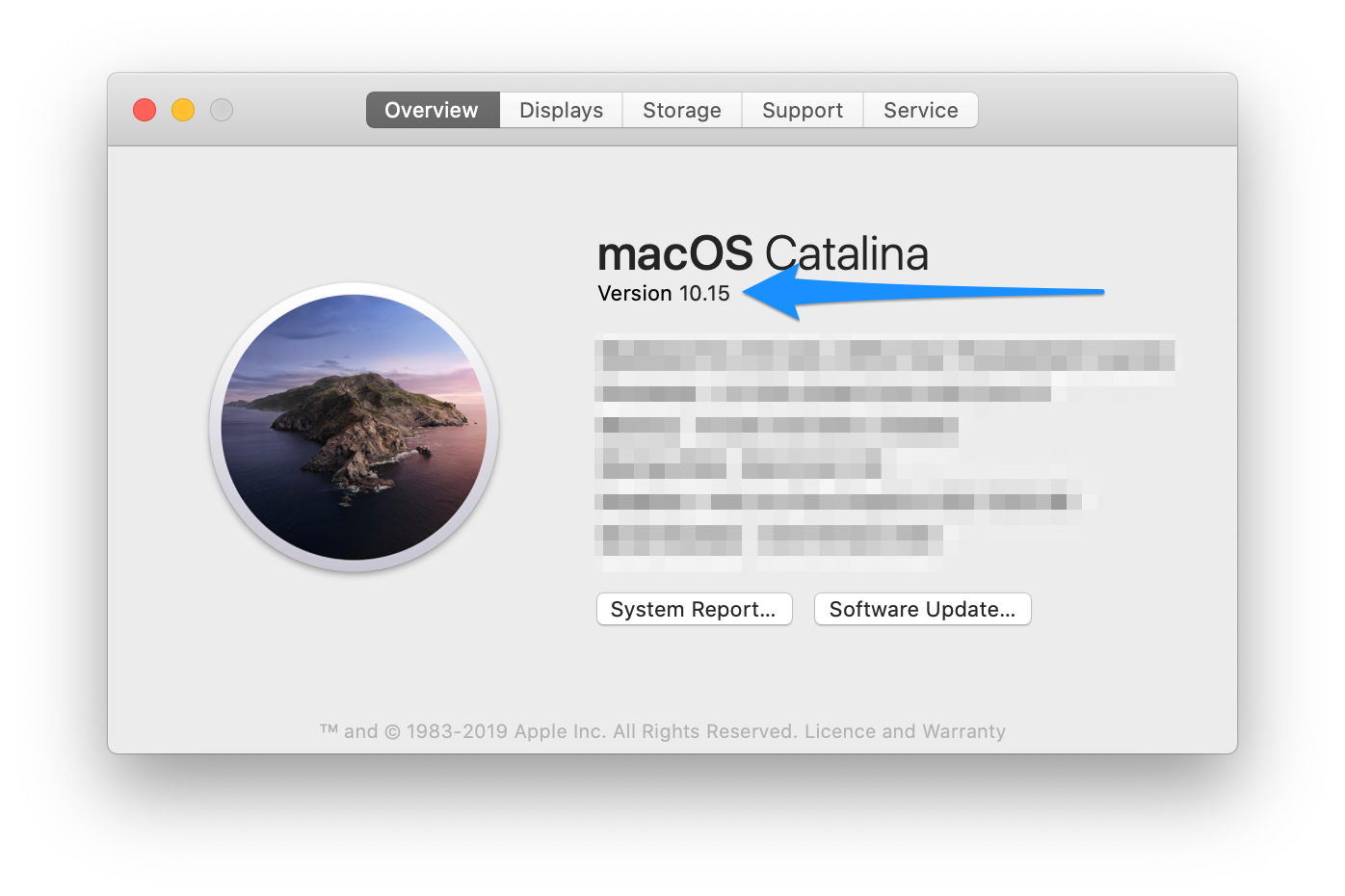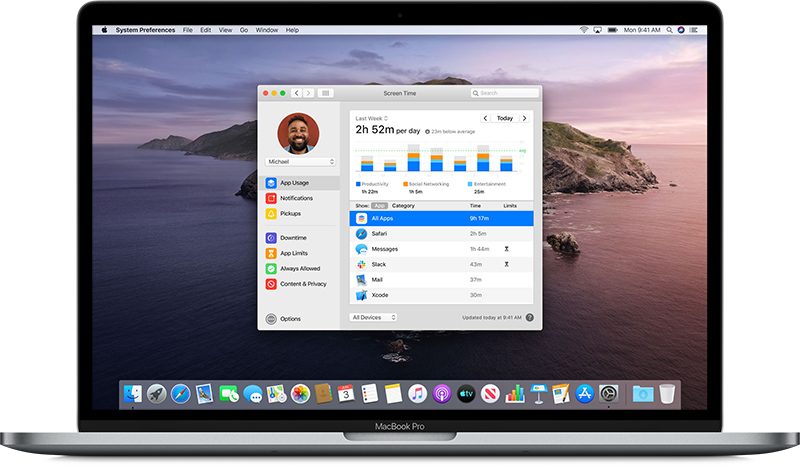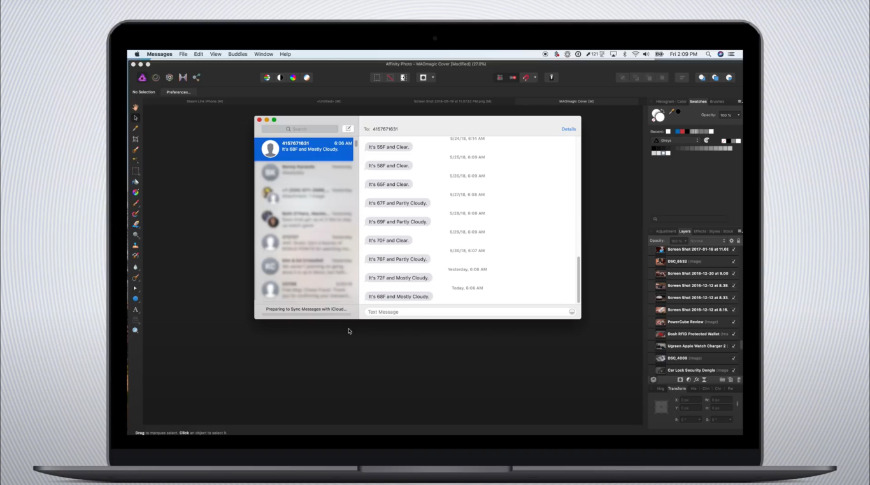Newest Version Of Mac Osx
Previous installers for OSX can be found here: download.gimp.org. An easy way to compile and install GIMP and other great Free software on your Mac is by using Macports. The installer allows you to choose from a large directory of packages. To install gimp using Macports, you simply do sudo port install gimp once you have Macports. Download RoboForm today. Available for Windows, Mac, iOS, Android, Linux, and Chrome OS.
- What Is The Latest Version Of Mac
- What Is The Newest Version Of Mac Os X
- Newest Version Of Mac Os X
- Mac Os X Version
- New Version Of Mac Os
- Latest Version Of Mac Os Download
Current Stable Version
The current stable release of GIMP is 2.10.22 (2020-10-04).
Pssst... want to check out the GIMP 2.99.4 development release?
Get it on our development downloads page.
We think your OS is Well, we don't actually know. Either JavaScript is disabled, or I am not working quite right... So I am showing you all the options.
Show downloads for GNU/Linux | OS X | Microsoft Windows | All
GIMP for Unix-like systems
If available, the official package from your Unix-like distribution is the recommended method of installing GIMP!
The flatpak build is new and has known limitations, though it will likely provide faster updates, following GIMP releases closely.
Therefore choose your installation medium according to your needs.
Flatpak build available in: x86-64, ARM and AArch64.
Flatpak additional instructions
The flatpak link above should open your software installer and prompt you to install GIMP. Yet it may not work out-of-the-box on some platforms since the flatpak technology is new. If that is the case, ensure flatpak is installed and if clicking the link still does not prompt to install GIMP, then manually install by command line:
flatpak install https://flathub.org/repo/appstream/org.gimp.GIMP.flatpakref
Once installed, it will be made available exactly the same way as other applications (menus, desktop overview, or any specific application launch process used by your desktop).
If this is not the case, we suggest to report a bug to your desktop or distribution asking for proper support of flatpak. In the meantime, you can still run it by command line (not as the recommended method, only a workaround):
flatpak run org.gimp.GIMP//stable
What Is The Latest Version Of Mac
This installation will also provide regular update. You don't have to come back on this page and install again (it will not work!) when a new version of GIMP is released. Instead if your distribution and/or desktop has a good support for flatpak, it should propose to perform updates.
Once again, if your distribution does not have proper support, you can always fall back to using the following command line:
flatpak update
Systems without flatpak support
GIMP can also run on Solaris and is available for the BSD family of systems such as FreeBSD and OpenBSD.
Please refer to the documentation for your Unix-like system on the installation of software.
GIMP for macOS
Updated on 2021-01-31: GIMP 2.10.22 DMG revision 3
Performance improvements on Big Sur and on previous macOS versions

The download links above will attempt to download GIMP from one of our trusted mirror servers. If the mirrors do not work or you would rather download directly from our server, you can get the direct download here.
Supported OS: macOS 10.9 Mavericks or over
Since the 2.8.2 version, GIMP runs on OSX natively. No X11 environment is required.
Native build
The official GIMP 2.10 DMG installer (linked above) is a stock GIMP build without any add-ons. Just open the downloaded DMG and drag and drop GIMP into your 'Applications' folder.
The SHA256 hash sum for gimp-2.10.22-x86_64-3.dmg is: 844dc06731cbd8ccaa6ffd4e0c74ad49ed1ecb6ae65db71988102acb6c219d56
Check it on VirusTotal: gimp-2.10.22-x86_64-3.dmg
Older Downloads
Previous installers for OSX can be found here: download.gimp.org.
Macports
An easy way to compile and install GIMP and other great Free software on your Mac is by using Macports. The installer allows you to choose from a large directory of packages. To install gimp using Macports, you simply do sudo port install gimp once you have Macports installed.
Last we checked, the GIMP port file pointed to the current stable release and we have reports from people who've built GIMP successfully this way.
Homebrew
Homebrew is similar to Macports and provides packages (aka formulas) to install, either by compiling them from source or by using pre-made binaries. There are indications that there is now a formula for GIMP, installable with: brew tap homebrew/cask && brew cask install gimp.

NOTE! Please be aware that it was announced recently that Homebrew is using analytics. To turn this off in homebrew then run: brew analytics off
You can read more about this on Brew Analytics.
Fink
Fink is a package repository that offer mostly precompiled binaries. It provides the apt-get command known to e.g. Debian and Ubuntu users, and installing GIMP is as easy as sudo apt-get install gimp once you have installed the Fink installer.
If there's no binary package, then fink install gimp will compile GIMP from source.
Disclaimer: we haven't been able to determine if it is possible to install or build recent GIMP from Fink. Last we checked, GIMP 2.6.12 appears to be the most recent GIMP package that is offered there.
GIMP for Windows
The download links above will attempt to download GIMP from one of our trusted mirror servers. If the mirrors do not work or you would rather download directly from our server, you can get the direct download here.
Supported OS: Windows 7 or over
These links download the official GIMP installer for Windows (~200 MB). The installer contains both 32-bit and 64-bit versions of GIMP, and will automatically use the appropriate one.
BitTorrent is a peer-to-peer file sharing system. It works by downloading GIMP from a distributed network of BitTorrent users, and may improve download speed dramatically. Choosing this option will download the torrent file for the GIMP installer. You may need to install a torrent client to make use of this file. Learn more...
Hash Sum
The SHA256 hash sum for gimp-2.10.22-setup.exe is: f7851c348584ce432dfd8e69b74a168c7dec33ebfddc29c96ad2d6b83aded083
Check it on VirusTotal: gimp-2.10.22-setup.exe
Older Downloads
- Previous v2.10 installers for Windows can be found here: download.gimp.org.
- Previous v2.8 installers for Windows can be found here: download.gimp.org.
GIMP User Manual
These links download language-specific Windows installers for GIMP's local help. By default, they will place the help files with your GIMP installation.
Note: GIMP uses online help by default. If you want to use this local help offline, you will need to change GIMP's help settings.
- In GIMP, select [Edit] > [Preferences] > [Help System]
- For 'User manual', select 'Use a locally installed copy'
- Under 'Help Browser', you can choose between your system's web browser and GIMP's help browser plugin (if available).
See the online help for more settings.
- Chinese Simplified (39 MB)
- Catalan (40 MB)
- Danish (39 MB)
- Dutch (39 MB)
- English (39 MB)
- English (United Kingdom) (39 MB)
- Finnish (39 MB)
- French (41 MB)
- German (41 MB)
- Greek (38 MB)
- Italian (43 MB)
- Japanese (39 MB)
- Korean (40 MB)
- Norwegian Nynorsk (35 MB)
- Portuguese Brazilian (40 MB)
- Romanian (39 MB)
- Russian (40 MB)
- Spanish (40 MB)
Source for version 2.10 (Stable)
GIMP releases available from gimp.org and its mirrors contain the source code and have to be compiled in order to be installed on your system.
For instructions, how to build GIMP from source code, please see this page.
GIMP 2.10.22 is now available at https://download.gimp.org/mirror/pub/gimp/v2.10/. You may want to read the Release Notes for GIMP 2.10.
To allow you to check the integrity of the tarballs, here are the hashes of the latest releases:
- gimp-2.10.22.tar.bz2 (sha256):
- 2db84b57f3778d80b3466d7c21a21d22e315c7b062de2883cbaaeda9a0f618bb
- gimp-2.10.20.tar.bz2 (sha256):
- e12f9f874b1a007c4277b60aa81e0b67330be7e6153e5749ead839b902fc7b3c
- gimp-2.10.18.tar.bz2 (sha256):
- 65bfe111e8eebffd3dde3016ccb507f9948d2663d9497cb438d9bb609e11d716
- gimp-2.10.16.tar.bz2 (sha256):
- cbf9fe9534b913a9487b00cd9710cbc569bfd71fdd2f8c321547701a7d70cbeb
- gimp-2.10.14.tar.bz2 (sha256):
- df9b0f11c2078eea1de3ebc66529a5d3854c5e28636cd25a8dd077bd9d6ddc54
- gimp-2.10.12.tar.bz2 (sha256):
- 7d80b58e0784120d57d327294f6a1fda281ff51a61935c2cd764da281acaac71
- gimp-2.10.10.tar.bz2 (sha256):
- 12d1f243265c7aee1f2c6e97883a5c90ddc0b19b4346cf822e24adbb6c998c77
- gimp-2.10.8.tar.bz2 (sha256):
- d849c1cf35244938ae82e521b92b720ab48b8e9ed092d5de92c2464ef5244b9b
- gimp-2.10.6.tar.bz2 (sha256):
- 4ec8071f828e918384cf7bc7d1219210467c84655123f802bc55a8bf2415101f
- gimp-2.10.4.tar.bz2 (sha256):
- ffb0768de14a2631b3d7ed71f283731441a1b48461766c23f0574dce0706f192
- gimp-2.10.2.tar.bz2 (sha256):
- 1cb0baaecdefe44d371a15f2739a1bcbce4682336b4ccf8eb7b587ce52c333eb
- gimp-2.10.0.tar.bz2 (sha256):
- 7fcc96fb88cb0a0595d2610f63a15dec245bb37bf9db527d37a24fb75e547de2
GIMP help files are available at https://download.gimp.org/mirror/pub/gimp/help/.
Please consider using one of the mirrors listed below.
Development snapshots
We now have a separate page for development versions of GIMP.
Want to check out the GIMP 2.99.4 development release?
Get it on our development downloads page.
FTP and Web Mirrors
We had a server move a while back that caused us to lose our existing mirrors (moved from physical to virtual server and to an environment that doesn't allow FTP access). On the plus side, we are now able to offer rsync access to download.gimp.org.
If you are running one of the existing GIMP mirrors, or want to create a new one, please contact us to get your rsync credentials.
- https://mirrors.ukfast.co.uk/sites/gimp.org/pub/gimp/
- ftp://mirrors.ukfast.co.uk/gimp.org/pub/gimp/
- rsync://mirrors.ukfast.co.uk/gimp.org/pub/gimp/
- Denmark
- https://mirrors.dotsrc.org/gimp/gimp/
- ftp://mirrors.dotsrc.org/gimp/
- rsync://mirrors.dotsrc.org/gimp/
- Finland
- https://www.nic.funet.fi/pub/mirrors/ftp.gimp.org/
- ftp://ftp.funet.fi/pub/mirrors/ftp.gimp.org/
- rsync://rsync.nic.funet.fi/ftp/pub/mirrors/ftp.gimp.org/
- France
- http://ftp.iut-bm.univ-fcomte.fr/gimp/
- ftp://ftp.iut-bm.univ-fcomte.fr/gimp/
- rsync://ftp.iut-bm.univ-fcomte.fr/gimp/
- Germany
- https://ftp.fau.de/gimp/gimp/
- ftp://ftp.fau.de/gimp/gimp/
- rsync://ftp.fau.de/gimp/
- https://ftp.gwdg.de/pub/misc/grafik/gimp/
- ftp://ftp.gwdg.de/pub/misc/grafik/gimp/
- https://artfiles.org/gimp.org/pub/gimp/
- Greece
- https://ftp.cc.uoc.gr/mirrors/gimp/
- ftp://ftp.cc.uoc.gr/mirrors/gimp/
- Japan
- http://www.ring.gr.jp/pub/graphics/gimp/
- Netherlands
- https://ftp.snt.utwente.nl/pub/software/gimp/gimp/
- ftp://ftp.snt.utwente.nl/pub/software/gimp/gimp/
- Philippines
- http://mirror.rise.ph/gimp/
- ftp://mirror.rise.ph/gimp/
- Poland
- https://ftp.icm.edu.pl/pub/graphics/gimp/
- ftp://ftp.icm.edu.pl/pub/graphics/gimp/
- rsync://ftp.icm.edu.pl/pub/graphics/gimp/
- gopher://ftp.icm.edu.pl/1/pub/graphics/gimp/
- Sweden
- https://ftp.lysator.liu.se/pub/gimp/
- ftp://ftp.lysator.liu.se/pub/gimp
- rsync://ftp.lysator.liu.se/pub/gimp
- Ukraine
- https://gimp.ip-connect.info/gimp/
- rsync://gimp.ip-connect.info/gimp/
- ftp://gimp.ip-connect.info/mirror/gimp/
- https://mirror.klaus-uwe.me/gimp/gimp/
- ftp://mirror.klaus-uwe.me/gimp/
- rsync://mirror.klaus-uwe.me/gimp/
- United Kingdom
- https://www.mirrorservice.org/sites/ftp.gimp.org/pub/gimp/
- ftp://ftp.mirrorservice.org/sites/ftp.gimp.org/pub/gimp/
- rsync://rsync.mirrorservice.org/ftp.gimp.org/pub/gimp/
- United States
- https://mirror.jaleco.com/gimp/gimp/
- https://mirror.umd.edu/gimp/gimp/
- http://gimp.cp-dev.com/
- ftp://devhost.cp-dev.com/gimp
- rsync://gimp.cp-dev.com/gimp
- https://mirrors.syringanetworks.net/gimp/gimp/
- ftp://mirrors.syringanetworks.net/gimp/
- rsync://mirrors.syringanetworks.net/gimp/
- https://mirrors.xmission.com/gimp/gimp/
- ftp://mirrors.xmission.com/gimp/gimp/
The Beginners Guide has general help. Click here for the Beginners Guide
If you need Mac-specific help, you are at the right page.
Join the Mailing list & search the archives for similar problem reports & how they were resolved, and/or ask the group. Please include enough info about the problem and situation so the community will be able to help you.
Not all functionality is supported on all radios. See Model Support
As of MacOS 10.9, signed packages are required by default. Apple charges for this capability, and requires use of their tooling to do it. For the time being, MacOS users may need to disable signed package checking for CHIRP. Instructions provided by Jim, K2SON:
- Locate the app in Finder.
- Right click (control-click if you don't have a 2 button mouse) on the app and click Open.
- You will get a dialog box about it being an unsigned app, click the Open button.
- Enter an Administrator userid and password.
- The app will now be flagged to allow it to be opened normally in the future.
Alternately, you can disable them for your entire system, although this has security implications that should not be ignored. Instructions for this provided by Tom, KD7LXL:
- Open your System Preferences
- Go to Security & Privacy, General tab.
- Click the lock
- Then choose Allow apps downloaded from: Anywhere.
As of 10.12 (Sierra) the UI for disabling app security was removed. The functionality is still there, but must be enabled from the command line.
To whitelist a single application (like an unzipped chirp-daily.app):- unzip chirp.zip
- control click on the unzipped application and select New Terminal at Folder. (Don't see that menu item? Instructions to enable it)
- run this command in the newly opened terminal window:
Alternately, you can disable them for your entire system, although this has security implications that should not be ignored. Run this command in a terminal:
references: single commandglobal
Unfortunately, Apple has made significant changes in 10.15 which cause major issues for independent software developers. CHIRP is significantly impacted and the future is unclear.
What Is The Newest Version Of Mac Os X
At the very least, Catalina users should use the 'unified' build of the app provided on the download page, which uses the system's 64-bit python runtime. Also note that there are significant limitations on what files unsigned applications can access which makes it very difficult to open, save, find, and otherwise organize image and CSV files with chirp. Please see issue #7147 for the current information about workarounds.
USB to serial cables are not merely wire, they contain small computer circuits at one end of the cable that respond as a USB device and convert the data to serial. These cables are not all the same, so the computer needs a software 'driver' so it can recognize the cable and speak to it correctly. You will need to install one of these 5 below.
FTDI cables¶
Note that with Mac OSX 10.9 'Mavericks', Apple provides their own driver for FTDI chipset. You may need to remove the OEM FTDI driver and use only the Apple FTDI driver, or you may need to disable the Apple FTDI driver and install the OEM FTDI drivers. YMMV.
http://www.ftdichip.com/Drivers/VCP.htm
Version 1.5.1 is available for Mac OS X on 64 bit, 32 bit and PPC machines.

Prolific PL-2303 cables - official drivers for the genuine Prolific cables¶
FYI: your cable, if using Prolific chipset, is more likely to be using a counterfeit chip than an original.
http://www.prolific.com.tw/US/CustomerLogin.aspx
Login as guest/ guest & look in the Support section. Specified to work with Mac OSX 10.6, 10.7, & 10.8.
Generic PL-2303 cables (counterfeit and/or “Generic”) If you aren't sure what kind of inexpensive cable you have, try this one first.¶
For Lion (10.7.x), Mountain Lion (10.8.x), and Mavericks (10.9.x):¶
You can try this one, which install open source pl2303 driver and remove any other driver versions:
http://1drv.ms/Nl68Ru At this web page you may need to right-click or control-click to link to get it to download. After downloading, you may need to control-right click, then open in order to bypass Mac Gatekeeper.
Newest Version Of Mac Os X
For earlier versions of Mac OS X up to 10.5 Leopard. Also some reports of success with Snow Leopard, Lion:¶
RTSystems cables¶
for OSX 10.9.x (aka Mavericks):¶
see RTSystemsCablesAndMavericks
for OSX < 10.9.x:¶
https://www.rtsystemsinc.com/kb_results.asp?ID=9
http://www.rtsystems.us/downloads/MacDrivers/RTSystemUSBSerialDrivers.pkg.mpkg.zip
Silicon Labs CP210x USB to UART Bridge VCP Drivers (including Kenwood TH-D72)¶
- http://www.silabs.com/products/mcu/Pages/USBtoUARTBridgeVCPDrivers.aspx
Macintosh OSX driver for the Intel and PowerPC Platforms versions 10.4, 10.5, 10.6, 10.7, 10.8, and 10.9.
WinChipHead CH340 series chipset¶
The WinChipHead CH340 series chipset is not compatible with the Prolific 2303 drivers. This chipset will report a Product ID of 0x7523 and a Vendor ID of 0x1a86. A signed driver compatible with Yosemite is available from http://blog.sengotta.net/signed-mac-os-driver-for-winchiphead-ch340-serial-bridge/ as the driver offered on the manufacturer's website (in Chinese) is not signed and requires allowing unsigned kernel extensions, which is a significant security risk on OS X.
- In many cases you need to connect the cable to the radio first, then power the radio on, while holding down some buttons. The exact procedure varies by radio.
- Some radios need to be put into a 'clone' mode to transfer to PC, some radios may need to be configured to use the mic/speaker jacks for PC transfer instead of for the speaker/mic. The exact procedure varies by radio.
- You will need to download from the radio to CHIRP first, before uploading anything to the radio. CHIRP creates a template from the radio download so it knows how to talk to the radio.
- If you want to download from one radio and upload those settings to another radio, first download from each radio to a separate “tab” of CHIRP. Then copy/paste from one tab to the other & upload back to the same radio that produced that tab. Do not try to upload to a radio directly from a tab that was not downloaded from that same radio.
- Many USB to serial cables include a counterfeit Prolific chip. This can cause connection problems because the official Prolific driver will ignore the counterfeit chip. Some people have reported success by using an older version of the Prolific driver, or a 3rd party driver.
- If you are using multiple USB cables, each will create a different “virtual port”, meaning that you will need to select the correct virtual port for your radio when connecting to your radio. CHIRP will give you this opportunity each time you download from the radio.
- If CHIRP won’t launch & won't run, you may have neglected to install the Python runtime. CHIRP needs that. Even though Mac OS X includes Python built-in, the runtime has to be installed is because it includes PyGTK and some other libraries that Chirp requires, in addition to Python itself: http://www.d-rats.com/download/OSX_Runtime/
- If your radio is not 'Supported', you can try downloading the newest Daily Build to see if support was recently added.
Mac Os X Version
You can verify that the drivers are installed & working by connecting the USB cable to your Mac, then running “System Profiler”, or “System Information” (found in /Applications/Utilities ). When the USB cable is connected and drivers correctly installed, the cable will show up in the USB section of the System Profiler.
Another way to see that the driver is correctly installed is to open Terminal and type:
It will return a list of virtual serial ports including something similar to:
You may also type:
That will return a long list of kexts, including something similar to this at the bottom (most recently installed are listed last):
New Version Of Mac Os
Look at the CHIRP log for clues.
Latest Version Of Mac Os Download
Join the Mailing list & search the archives for similar problem reports & how they were resolved, and/or ask the group. Please include enough info about the problem and situation so the community will be able to help you.
